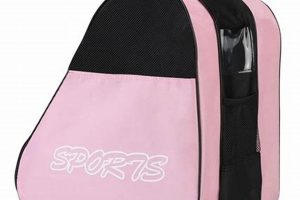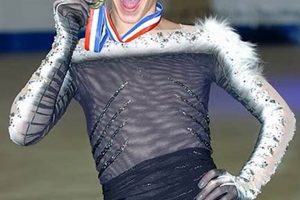The distinction between blade designs and boot construction is significant when selecting appropriate footwear for ice skating. One option prioritizes stability and edge control for performing jumps and spins. The alternative is engineered for speed, maneuverability, and protection during fast-paced team play. Understanding these fundamental differences is crucial for individuals new to the ice.
The choice of ice skate impacts the learning curve and potential for progress in different skating disciplines. Selecting the correct type can foster confidence and enjoyment, reducing the risk of injury and promoting skill development. Historically, advancements in skate technology have catered to specialized requirements within the sport, leading to the development of distinct features designed to enhance performance and safety.
This analysis will explore the key characteristics differentiating the two primary types of ice skates. It will delve into the unique design elements of each, including blade curvature, boot stiffness, and support features, to facilitate an informed decision-making process for novice skaters.
Guidance for New Ice Skaters
Selecting the appropriate type of skate is crucial for a positive initial experience on the ice. The following guidance addresses critical factors to consider when deciding between the two primary types.
Tip 1: Intended Use. Determine the primary skating activity. Figure skating emphasizes artistry and technical jumps and spins, while hockey focuses on speed, agility, and team play.
Tip 2: Blade Configuration. Observe the blade design. Figure skates feature a longer, flatter blade with a toe pick for jumps. Hockey skates possess a shorter, more curved blade for enhanced maneuverability.
Tip 3: Ankle Support. Assess boot stiffness and ankle support. Figure skates offer rigid support for stability during jumps and landings. Hockey skates provide more flexibility for dynamic movement.
Tip 4: Comfort and Fit. Prioritize a snug, comfortable fit. Ill-fitting skates can cause blisters, discomfort, and hinder skill development. Professional fitting services are recommended.
Tip 5: Rental Options. Consider renting both types of skates initially. This allows for direct comparison and provides insight into individual preferences before making a purchase.
Tip 6: Learning Resources. Explore available learning resources. Group lessons and beginner programs often cater specifically to either figure skating or hockey, and the appropriate skate type will enhance the learning experience.
Tip 7: Budget Considerations. Establish a budget. Skate prices vary, and initial cost should factor into the decision, considering that both disciplines may require additional equipment.
Selecting the correct skate enhances initial learning and long-term enjoyment. Prioritizing intended use, blade design, and fit maximizes the probability of a successful and enjoyable skating experience.
The subsequent section will provide a detailed analysis of specific skate features and their implications for beginner skaters.
1. Blade Curvature
Blade curvature represents a fundamental distinction between figure and hockey skates, influencing maneuverability, stability, and suitability for different skating disciplines. This parameter affects how the skater interacts with the ice, directly impacting a beginner’s learning curve and overall experience.
- Rocker Profile and Agility
The rocker, or curvature, of the blade determines the contact area with the ice. Hockey skates exhibit a smaller radius of curvature, resulting in a more pronounced rocker. This design enhances agility, facilitating quick turns and rapid changes in direction essential for hockey gameplay. A beginner using hockey skates will find it easier to execute tight turns and maintain speed during maneuvers.
- Blade Length and Stability
Figure skate blades are typically longer and flatter, providing a larger contact area with the ice. This design promotes stability and edge control, crucial for performing jumps and spins. The increased length provides a more stable platform for landings, while the flatter profile allows for precise edge work necessary for figure skating elements. A beginner in figure skating benefits from this stability when learning fundamental techniques.
- Turning Radius and Skill Progression
The turning radius is directly related to the blade’s curvature. Hockey skates, with their tighter turning radius, enable quicker and sharper turns. Figure skates, with a larger turning radius, require more deliberate weight shifts and edge control for similar maneuvers. This difference necessitates specific skill development pathways; hockey requires rapid response and agile footwork, while figure skating emphasizes controlled movements and precise blade placement.
- Initial Learning Experience and Confidence
For a beginner, the blade curvature can significantly impact the initial learning experience. Hockey skates may feel more intuitive for learning basic skating skills due to their enhanced maneuverability. However, the stability of figure skates can provide a sense of security for those new to the ice. The choice depends on individual learning style and preference, but understanding the implications of blade curvature is essential for making an informed decision.
In summary, blade curvature is a critical factor differentiating figure and hockey skates, directly influencing maneuverability, stability, and overall skating experience. For beginners, understanding these distinctions aids in selecting the appropriate skate type, promoting skill development and fostering a positive initial interaction with the sport.
2. Ankle Support
Ankle support constitutes a critical element in distinguishing figure skates from hockey skates, influencing stability, maneuverability, and injury prevention, particularly for novice skaters. The design and construction of the boot directly impact ankle stabilization, affecting skill acquisition and confidence on the ice.
- Boot Stiffness and Stability
Figure skates typically feature significantly stiffer boots compared to hockey skates. This rigidity provides substantial ankle support, crucial for absorbing impact during jumps and landings. The enhanced stability minimizes the risk of ankle rolling or injury, allowing beginners to focus on technique without fear of instability. Examples include reinforced leather or synthetic materials combined with layered construction to maximize support.
- Flexibility and Agility
Hockey skates prioritize flexibility in the ankle region, enabling greater range of motion and agility. This design facilitates quick turns, rapid acceleration, and dynamic movements essential for hockey gameplay. While offering less direct ankle support, hockey skate construction emphasizes responsiveness and the ability to react swiftly to changing conditions. This contrasts with the rigid support found in figure skates, which restricts ankle movement in favor of stability.
- Lacing Systems and Customization
The lacing system plays a crucial role in ankle support. Figure skates typically employ a more elaborate lacing system extending higher up the ankle, allowing for customized tightness and support. Hockey skates generally utilize a simpler lacing system focusing on securing the foot within the boot while maintaining flexibility. Proper lacing technique is critical for both types of skates to optimize ankle support and prevent injury.
- Beginner Skill Acquisition and Injury Prevention
The level of ankle support influences the rate of skill acquisition and the potential for injury, particularly for beginners. Figure skating novices benefit from the stability of stiff boots, enabling them to learn jumps and spins with reduced risk of ankle strain. Hockey beginners require sufficient flexibility for basic skating techniques and maneuverability, with less emphasis on impact absorption. Selecting the appropriate level of ankle support based on the intended discipline is essential for promoting a safe and successful learning experience.
The interplay between boot stiffness, lacing systems, and intended discipline dictates the optimal level of ankle support. Understanding these nuances is critical for novice skaters when choosing between figure and hockey skates. This choice directly influences their ability to develop fundamental skills, maintain balance, and minimize the risk of ankle-related injuries, ultimately shaping their initial experience on the ice.
3. Toe Pick Presence
The toe pick, a series of jagged teeth located at the front of a figure skate blade, constitutes a defining feature differentiating it from hockey skates, which lack this appendage. This presence significantly impacts the function and intended use of the skate, particularly for beginners exploring different ice skating disciplines. The toe pick’s primary purpose is to assist in specific figure skating movements, such as jumps, spins, and footwork sequences. Its absence on hockey skates reflects the differing demands of that sport, where fluid gliding and rapid changes in direction are paramount, and the toe pick would impede performance.
The toe pick facilitates jumps by providing a point of leverage for launching into the air. For instance, in a toe loop jump, the skater strikes the ice with the toe pick of one skate while rotating and taking off with the other. Spins are initiated and controlled, in part, using the toe pick to maintain a tight axis of rotation. Additionally, intricate footwork sequences often incorporate the toe pick for precise movements and edge control. However, for a beginner unfamiliar with these techniques, the toe pick can present a significant obstacle. Accidental engagement of the toe pick can lead to tripping or stumbling, hindering the development of basic skating skills and potentially causing injury. Hockey skates, devoid of this feature, allow for smoother gliding and easier mastery of fundamental skating techniques such as forward skating, backward skating, and stopping.
In conclusion, the presence or absence of the toe pick is a fundamental discriminator when selecting skates for beginners. Figure skates, with their toe picks, are designed for specialized maneuvers in figure skating, while hockey skates prioritize agility and ease of movement in hockey. For a novice skater, the choice hinges on the intended skating discipline and the willingness to learn the specific techniques associated with the toe pick. Initial experimentation with both types of skates may be beneficial to determine personal preference and suitability for different skating styles. The removal of the toe pick will make the figure skate basically useless. The addition of a toe pick on a hockey skate will make it dangerous.
4. Boot stiffness
Boot stiffness represents a critical differentiating factor between figure skates and hockey skates, significantly impacting a beginner’s learning curve, skill development, and injury risk. The rigidity of the boot directly influences ankle support, stability, and control, ultimately determining the suitability of each skate type for specific skating disciplines. Cause-and-effect relationships are evident: stiffer boots provide greater ankle support, leading to enhanced stability for jumps and landings in figure skating. Conversely, less rigid boots offer increased flexibility, facilitating agility and maneuverability in hockey.
The importance of boot stiffness as a component is paramount. For instance, a beginner attempting figure skating jumps in hockey skates, characterized by softer boots, would experience inadequate ankle support, increasing the likelihood of ankle injuries and hindering proper technique. Conversely, a hockey player using figure skates would find the stiff boot restrictive, limiting their range of motion and hindering their ability to execute quick turns and powerful strides. Real-life examples include professional figure skaters relying on custom-molded, highly rigid boots for optimal performance and injury prevention, while hockey players often select boots with a degree of flexibility to enhance responsiveness and agility on the ice. This understanding translates into practical significance when selecting skates, as aligning boot stiffness with the intended skating discipline is essential for promoting skill development, preventing injuries, and ensuring a positive initial experience. Selecting skates without this parameter in mind can lead to bad injury.
In summary, boot stiffness is a pivotal element dictating the functionality and suitability of ice skates for different skating disciplines. The differing stiffness levels found in figure and hockey skates cater to the unique demands of each sport, influencing ankle support, stability, and maneuverability. For beginners, careful consideration of boot stiffness is crucial for promoting a safe, enjoyable, and productive learning experience, as it directly impacts skill acquisition, injury prevention, and overall confidence on the ice. Neglecting this factor can lead to frustration, injury, and potentially hinder long-term participation in the sport.
5. Intended discipline
The intended disciplinefigure skating or hockeyis the foundational determinant in the choice between figure skates and hockey skates for beginners. This initial consideration dictates the required features and performance characteristics of the appropriate skate, directly influencing the skater’s learning curve and potential for success. Ignoring this principle results in compromised performance and heightened risk of injury.
- Figure Skating Requirements
Figure skating emphasizes artistry, precision, and technically demanding jumps and spins. Figure skates are engineered to facilitate these elements, featuring a longer, flatter blade with a toe pick for jump assistance and rigid ankle support for stability upon landing. These features are detrimental to hockey performance but essential for figure skating skill development. Failure to use figure skates in this discipline compromises the ability to learn these key techniques and increases the risk of ankle injuries. Beginners cannot do the required figure skating elements without using the right skate gear.
- Hockey Demands
Hockey prioritizes speed, agility, and protection during dynamic gameplay. Hockey skates are designed with a shorter, more curved blade for maneuverability and a more flexible boot for responsiveness. They also incorporate robust protective elements to withstand impacts. These features hinder figure skating performance but are critical for safe and effective hockey play. Attempting hockey maneuvers in figure skates restricts mobility and increases the risk of injury from falls and collisions.
- Skill Acquisition Trajectory
The intended discipline shapes the skill acquisition trajectory. Figure skating requires mastering edge control, balance, and jump techniques, facilitated by the specific design of figure skates. Hockey involves developing skating speed, agility, and puck-handling skills, best achieved with hockey skates. Using the incorrect skate hinders the development of the appropriate skills, prolonging the learning process and potentially leading to frustration. It is impossible to make good hockey playing abilities if you are using figure skates. It is also impossible to master figure skating when using hockey skates.
- Safety Considerations
Safety is paramount when choosing skates. Figure skates lack the protective features necessary for hockey, leaving the skater vulnerable to impacts and collisions. Hockey skates restrict ankle movement required for certain figure skating jumps, potentially leading to ankle strain or injury. Selecting the appropriate skate type mitigates these risks, ensuring a safer and more enjoyable experience for beginners. The protective support the ankle boot and strong plastic shell has is impossible to replace when playing hockey. The risk of injury in hockey increase by a big factor if you are using figure skates.
The fundamental connection between intended discipline and skate selection cannot be overstated. Understanding the unique demands of figure skating and hockey, and choosing skates accordingly, is the cornerstone of a positive and successful beginning in either sport. It’s the starting point of beginning either sport.
6. Maneuverability
Maneuverability, defined as the ability to execute rapid turns and changes in direction, is a critical performance parameter differentiating figure skates and hockey skates. For beginners, the impact of skate design on maneuverability directly influences the learning curve and the capacity to perform fundamental skills within each respective discipline. The differing design philosophies of figure and hockey skates prioritize maneuverability to varying degrees, creating distinct advantages and disadvantages depending on the intended application. A novice skater’s initial experience is significantly shaped by the inherent maneuverability characteristics of the chosen skate type.
Hockey skates, characterized by a shorter, more curved blade, exhibit enhanced maneuverability compared to figure skates. This design facilitates tighter turning radii and quicker directional changes, essential for the dynamic and fast-paced nature of hockey. Conversely, figure skates, with their longer, flatter blades, prioritize stability and edge control, compromising maneuverability to some extent. This difference is particularly evident when comparing the turning techniques employed in each discipline. Hockey players rely on rapid weight shifts and agile footwork to execute sharp turns, while figure skaters emphasize controlled edge work and deliberate movements. The contrasting requirements of each sport necessitate these distinct design approaches. For example, a hockey player attempting to navigate a crowded ice surface in figure skates would find their maneuverability severely restricted, hindering their ability to evade opponents and maintain speed. A figure skater performing intricate footwork sequences in hockey skates would struggle to maintain balance and control due to the reduced blade surface and increased curvature.
In summary, maneuverability represents a key distinction between figure and hockey skates. The design trade-offs inherent in each skate type cater to the specific demands of their respective disciplines. Beginners should carefully consider their intended skating activity and prioritize maneuverability accordingly. Selecting the appropriate skate based on this factor is essential for promoting skill development, minimizing frustration, and maximizing the overall enjoyment of the skating experience. Incorrect selection based on design can hinder the long-term abilities of a beginner to get good on the ice.
7. Protection
Safety considerations are paramount when selecting ice skates, particularly for beginners. The level of protection offered by figure skates and hockey skates differs significantly, reflecting the inherent risks associated with each discipline. These differences in protection directly impact injury prevention and the overall skating experience, especially for those new to the ice.
- Boot Construction and Impact Resistance
Hockey skates prioritize impact resistance due to the high-contact nature of the sport. The boots are typically constructed from reinforced materials, such as molded plastic or composite materials, providing substantial protection against pucks, sticks, and collisions with other players. In contrast, figure skates generally offer less impact protection, as the sport involves fewer direct physical impacts. Figure skate boots often emphasize flexibility and support for jumps and landings, rather than rigid protection against external forces. For instance, a hockey skate can withstand the impact of a puck traveling at high speed, whereas a figure skate may not provide adequate protection in a similar scenario.
- Ankle Support and Injury Prevention
While both skate types provide ankle support, the design and purpose differ. Hockey skates offer lateral support to prevent ankle twisting during quick turns and movements, but may allow for greater forward flexion for agility. Figure skates offer rigid, all-around ankle support, crucial for stabilizing the ankle during jumps and landings. The enhanced stability of figure skates reduces the risk of ankle sprains, particularly for beginners learning complex maneuvers. However, hockey skates also incorporate padding and reinforcement to protect the ankle from impacts, albeit with a focus on mobility.
- Blade Guards and External Hazards
Regardless of skate type, blade guards are essential for protecting the blades from damage when off the ice. Walking on hard surfaces without blade guards can dull the edges, compromising performance and safety. However, blade guards do not provide protection from impacts during skating. Additional protective gear, such as shin guards and helmets, are crucial for both figure skating and hockey, particularly for beginners who are more susceptible to falls and collisions. In a practical sense, blade guards preserve the integrity of the skate blade, ensuring optimal performance and extending the lifespan of the skates, but they are not a substitute for impact-resistant features.
- Padding and Internal Comfort
Both figure skates and hockey skates incorporate internal padding for comfort and shock absorption. However, hockey skates often feature denser padding in key areas, such as the tongue and ankle, to provide additional protection against impacts. Figure skates may prioritize thinner padding to enhance feel and control, particularly for advanced skaters. For beginners, adequate padding is essential for both comfort and injury prevention, as it helps to absorb impact forces and reduce the risk of blisters and abrasions. Proper fit is also crucial, as ill-fitting skates can increase the risk of discomfort and injury, regardless of the level of padding.
The protective features of ice skates are intrinsically linked to the demands of the respective disciplines. Hockey skates prioritize impact resistance and lateral stability, while figure skates emphasize ankle support and stability for jumps. Beginners should carefully consider the inherent risks of each sport and select skates that provide adequate protection for their intended activity. Supplementing skates with additional protective gear, such as helmets and padding, further enhances safety and promotes a positive skating experience.
Frequently Asked Questions
This section addresses common inquiries and misconceptions surrounding the selection of ice skates for novice skaters. The information provided aims to clarify the distinctions between figure skates and hockey skates, facilitating informed decision-making.
Question 1: Are figure skates suitable for learning basic skating skills if I am unsure which discipline I prefer?
While figure skates can be used for initial skill development, the toe pick may hinder the learning process for some individuals. Hockey skates typically allow for a smoother gliding experience during the initial stages of learning to skate.
Question 2: Can hockey skates be used for figure skating jumps and spins?
Hockey skates lack the blade design and ankle support necessary for performing figure skating jumps and spins safely and effectively. Attempting these maneuvers in hockey skates is not recommended.
Question 3: What level of ankle support is most appropriate for a beginner?
Adequate ankle support is essential for beginners to prevent injuries and develop proper technique. Figure skates generally offer greater ankle support than hockey skates, which may be beneficial for novice skaters who require additional stability.
Question 4: How does blade curvature affect a beginner’s ability to turn and maneuver?
The more pronounced curvature of hockey skate blades facilitates tighter turns and quicker directional changes. Figure skate blades, with a flatter profile, require more deliberate weight shifts and edge control for similar maneuvers.
Question 5: Do hockey skates provide adequate protection for recreational skating?
Hockey skates offer enhanced protection against impacts, making them a suitable option for recreational skating, especially in crowded environments where collisions are more likely.
Question 6: Is it possible to modify figure skates for hockey or hockey skates for figure skating?
Modifying skates is generally not recommended, as it can compromise their structural integrity and safety. Each skate type is designed for a specific purpose, and altering its configuration may lead to performance issues and increased risk of injury.
The key takeaway is that the appropriate skate type should be chosen based on the intended discipline and individual preferences. Understanding the distinct features and functionalities of figure skates and hockey skates is crucial for a safe and enjoyable skating experience.
The subsequent section will provide concluding remarks on selecting the optimal ice skates for beginners.
figure skates vs hockey skates for beginners
This analysis has explored the multifaceted considerations involved in selecting between figure skates and hockey skates for those new to ice skating. Key distinctions encompassing blade design, boot construction, and intended discipline have been detailed, underscoring the impact of skate selection on skill acquisition, safety, and overall experience.
Informed decision-making based on individual needs and objectives is paramount. Choosing the appropriate skate type is not merely a matter of preference, but a foundational step towards achieving proficiency and mitigating risks. Continued diligence in seeking expert advice and prioritizing safety will contribute to a rewarding and enduring engagement with the sport of ice skating.






![Top Figure Skate Brands: Find Your Best Skates [Year] Learn to Surf & Skate: A Beginner's Step-by-Step Guide Top Figure Skate Brands: Find Your Best Skates [Year] | Learn to Surf & Skate: A Beginner's Step-by-Step Guide](https://universitysurfandskate.com/wp-content/uploads/2025/12/th-820-300x200.jpg)
